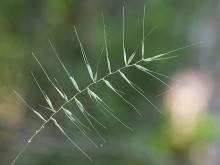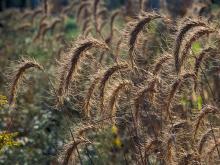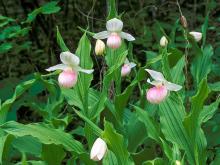Wildflowers, Grasses and Other Nonwoody Plants
Media

Species Types
Scientific Name
Elymus hystrix
Description
Bottlebrush grass is a native perennial, tuft-forming wild rye that typically grows in woodlands. The widely spaced spikelets spread away at a right angle from the main flowering stem.
Species Types
Scientific Name
Bromus pubescens (formerly B. purgans)
Description
Several species of brome grasses are found in Missouri. Canada brome, or hairy woodland brome, is one of the few that are native. It grows to 4 feet high, and its open flower clusters have drooping spikelets.
Media

Species Types
Scientific Name
Elymus canadensis
Description
Canada wild rye can be identified by its bristly seed heads, which curve downward. As the seeds mature, the straight, long awns curve and bend. This is a common native cool-season grass that reaches about 4 feet tall and is highly valued as forage and hay for livestock.
Media

Species Types
Scientific Name
Scrophularia marilandica
Description
Eastern figwort occurs statewide in rich woods, woodland borders, and bottomlands. It’s usually 2-5 feet high, has square stems and lance-shaped, toothed leaves, and bears spreading clusters of small, green scoop-shaped flowers with brown petal lobes.
Media

Species Types
Scientific Name
Viola viarum
Description
The leaf blades of plains, or wayside violet are highly variable, and the plant produces differently shaped leaves as the season progresses. It’s quite similar to cleft violet, but the leaves are smooth and hairless.
Media

Species Types
Scientific Name
Rumex crispus
Description
Curly dock’s rosettes of wavy-edged, leathery leaves are a common sight on roadsides and other disturbed lands. The fruit clusters at the top half of the plant turn dark rusty brown and are easy to spot from a distance.
Media

Species Types
Scientific Name
Cypripedium reginae
Description
Showy lady’s slipper is a beautiful and rare wildflower. This orchid can be more than 3 feet tall, with showy flowers with a pink-suffused, inflated lower lip. In Missouri, it's restricted to the southern portion of the Ozarks.
Media

Species Types
Scientific Name
Galearis spectabilis (formerly Orchis spectabilis)
Description
Showy orchis is a perennial wildflower of rich, moist, shady woods, slopes, ravines, and stream valleys, often found with other spring wildflowers. It’s about 6 inches tall when it produces its beautiful pink and white flowers.
Media

Species Types
Scientific Name
Cladophora, Pithophora, and Spirogyra spp., and others
Description
Filamentous green algae forms green, cottony masses that are free-floating or attached to rocks, debris, or other plants.
Media

Species Types
Scientific Name
Phlox divaricata
Description
A common, eye-catching native spring wildflower common in woodlands, blue phlox occurs nearly statewide.
See Also
About Wildflowers, Grasses and Other Nonwoody Plants in Missouri
A very simple way of thinking about the green world is to divide the vascular plants into two groups: woody and nonwoody (or herbaceous). But this is an artificial division; many plant families include some species that are woody and some that are not. The diversity of nonwoody vascular plants is staggering! Think of all the ferns, grasses, sedges, lilies, peas, sunflowers, nightshades, milkweeds, mustards, mints, and mallows — weeds and wildflowers — and many more!





















